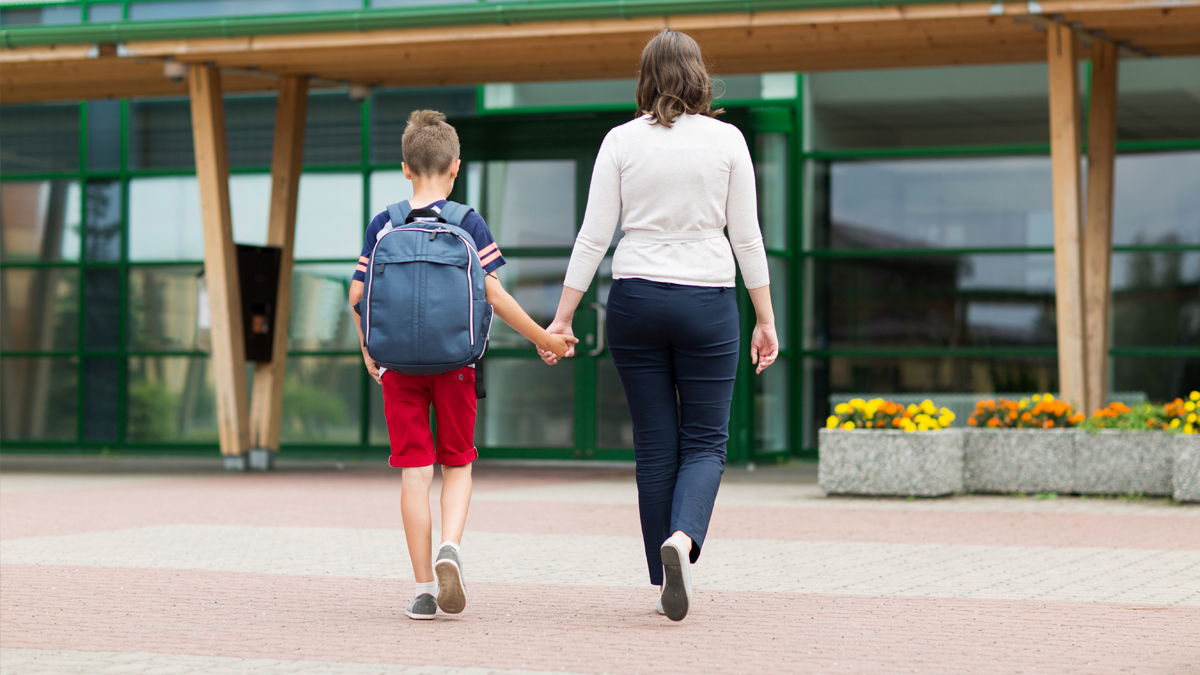Science Packs
Take-home STEM-themed backpacks provide opportunities for engaging family fun!
Families play a vital role in shaping students’ interest and engagement in science (Archer et al. 2012; Dabney, Chakraverty, and Tai 2013), yet are often left out of the loop. To encourage family involvement in science that is sustained over time, we took a cue from Freudenberg’s (2012) Science Sacks article and created science backpacks that students can take home over the weekends and share with their family members. We created three different activities for each grade level K–6, for a total of 21 different backpack activities throughout the school. Each classroom has duplicates of each activity, so it takes approximately 15 weeks (longer in reality, due to shortened weeks, holidays, and so on) for each child/family to complete each of the three activities.
We believe that the backpacks are an important step in including families in science education. Since our initial implementation in 2015, families have provided feedback that they appreciate having all the materials put together for them so that the barrier to doing science activities is lowered. Fully 100% of respondents on the backpack feedback forms have stated that their child had learned something new from the activity and made comments such as, “The backpacks brought a lot of exciting new knowledge into our home.” But perhaps most exciting is that the backpacks seem to be a launching point for future family conversations and activities without the support of the school, as evidenced by these comments: “The backpack was a very good activity we both could do, and we started talking about other things we could do like that at home,” and “He really likes [the backpacks]…We’ve talked about future jobs that he didn’t really know about before.” In fact, 98 percent of respondents on the backpack feedback forms said that the backpacks helped them connect with their child (54% strongly agree, 44% agree).
This article will provide details as to how we set up our backpacks and how other schools can start up a similar program. We will profile our kindergarten backpack activity on making a kite (see Supplemental Resources for the full activity including recording sheets); the full list of our activities can be found in Table 1.
Backpack Materials
Each backpack contains directions for a hands-on science activity that is aligned to grade-level Next Generation Science Standards (NGSS; NGSS Lead States 2013) performance expectations, materials for that activity, a student recording sheet, a lab assistant’s page, and a feedback form. Most backpacks in grades K–2 also come with a picture book related to the topic to better connect science to literacy skills younger students are working on; connections to the English Language Arts Common Core State Standards are noted for families in these activities.
To help both families and those who restock the backpacks when they are returned to school, we have pictures of what should be returned and what can be discarded or recycled (see Figure 1). Materials are purchased with grant funding and consumable items are replenished by volunteers.
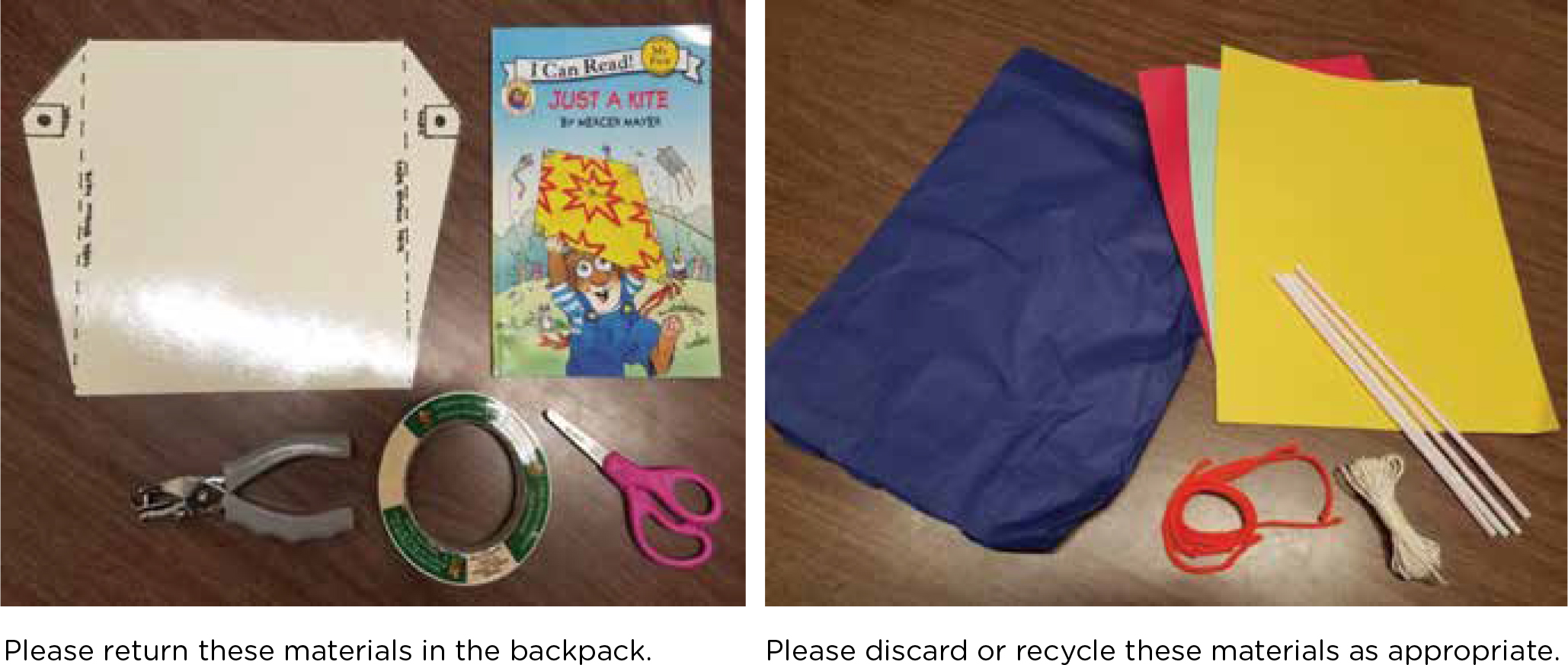
Selecting Activities
Many activities were found online and adapted for our purposes so that they would (a) better align with grade-level NGSS performance expectations, (b) not feel intimidating to families who feel uncomfortable with science, and (c) work well with easy-to-obtain (ideally grocery-store) materials. This last point is key, as we wished to demonstrate to families that science can be done with everyday, inexpensive materials; only four of our backpacks contained what could be considered “specialized” science materials or kits.
To ensure that the activities were in line with the NGSS three-dimensional vision for science, we focused on the science and engineering practices and what students would be doing with their families. For example, in the second-grade parachute building activity, we focused on K-2-ETS1-3 and the practice of Analyzing and Interpreting Data; as such, we asked students to record data from their tests and consider which design performed better. Similarly, in the fourth-grade activity on electricity, we focused on 4-PS3-2 and the practice of Planning and Carrying Out Investigations; here, we asked students to use a circuitry kit to create a number of different configurations and make observations about how the energy could be flowing through the configurations. Note that many of our activities are somehow connected to ideas of space, as our initial funding for the idea came from the NASA Idaho Space Grant Consortium. However, we do not feel that activities need to connect thematically in order to work for your school or classroom. Each activity sheet contained the following components:
- NGSS performance expectation
- ELA and/or Math CCSS when relevant
- Background information: 2–4 sentences that tell families what the activity is about
- Questions to consider: 3–4 questions families can keep in mind during the activity
- Materials list
- Safety notes
- Procedures
- Extensions— activities families could do to go above and beyond the activity
- Online resources: 3–4 links that would provide more content information or other related activities
- Local resources: places families could visit or organizations they could connect with to learn more about the topic or just have fun
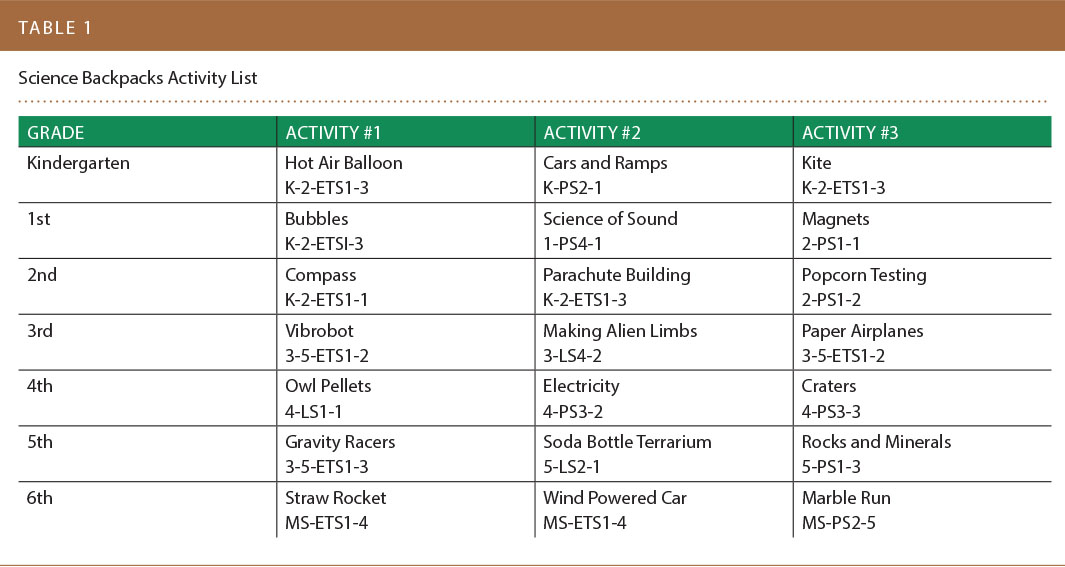
Including Paperwork
Following Freudenberg’s suggestions in her Science Sacks article, we included a page in our backpacks that would help family members facilitate the activity. We chose to call this the “Lab Assistant’s Page” to be sensitive to the varied family structures within our school as well as to signal to family members that anyone can be a scientist. In addition to science or engineering content and safety points, this page also contains guiding questions that could be asked as children are working through the activities. We saw this as a crucial component of the backpacks, as we wanted to model how to ask questions that promote understanding, with the hope that families could take this type of questioning up as they do other science-related activities at home. When applicable, there are also guiding questions for the picture books that encourage text-to-self and text-to-world connections.
Each backpack has a Student Recording Sheet to support students in thinking more deeply about the content at hand. This Recording Sheet also models for students that scientists and engineers collect and report data. For example, in the kindergarten backpack about making a kite, the Recording Sheet (read by an adult) guides students through a very basic engineering design cycle (e.g., Engineering is Elementary 2019), asking the questions:
- DESIGN— Why did you choose a certain material to make your kite?
- TRY IT OUT!— Draw what happened when you launched your kite.
- REDESIGN— Try a different material or design. What does it look like? Draw it here.
- TRY IT AGAIN!— Try out your new kite. Draw a picture of what happened when you launched your kite. Did anything different happen this time?
For upper elementary students, the recording sheet in a backpack about making a wind-powered car follows a similar engineering design cycle, but with more sophisticated prompts to perform different trials, record data as they see fit, and analyze the data.
Finally, each backpack contains a 10-item feedback form for families to fill out and return with the backpacks. Although most questions are logistical in nature (i.e., materials, developmental appropriateness, etc.) other questions include “Do you feel your child learned more about science/STEM from doing this activity?” and “Do you have any suggestions for us to improve the backpack activities?” Feedback from families has prompted us to make important changes to the activities over time, such as providing different materials, more details in instructions, or changing out activities altogether. For example, based on feedback that an activity using glowsticks to illustrate absolute and apparent brightness of stars was ineffective, we decided to discontinue the activity.
Given the diversity of the students and families at our school in terms of languages, cultures, and abilities, we were thoughtful about the construction of all print materials. Students and families in our school speak 18 different languages, making it unrealistic to translate all of our materials; as a result, we chose English as the lingua franca for all documents. However, we kept language simple and tried to include as many pictures and diagrams as possible to aid in reading. In terms of differentiation within the activities themselves, we do not provide specific instructions; rather we purposefully chose activities with which we assumed most families might have experience (e.g., kites, bubbles, magnets, ramps), with the thought that families know their children best and could naturally fine-tune activities to meet students’ needs.
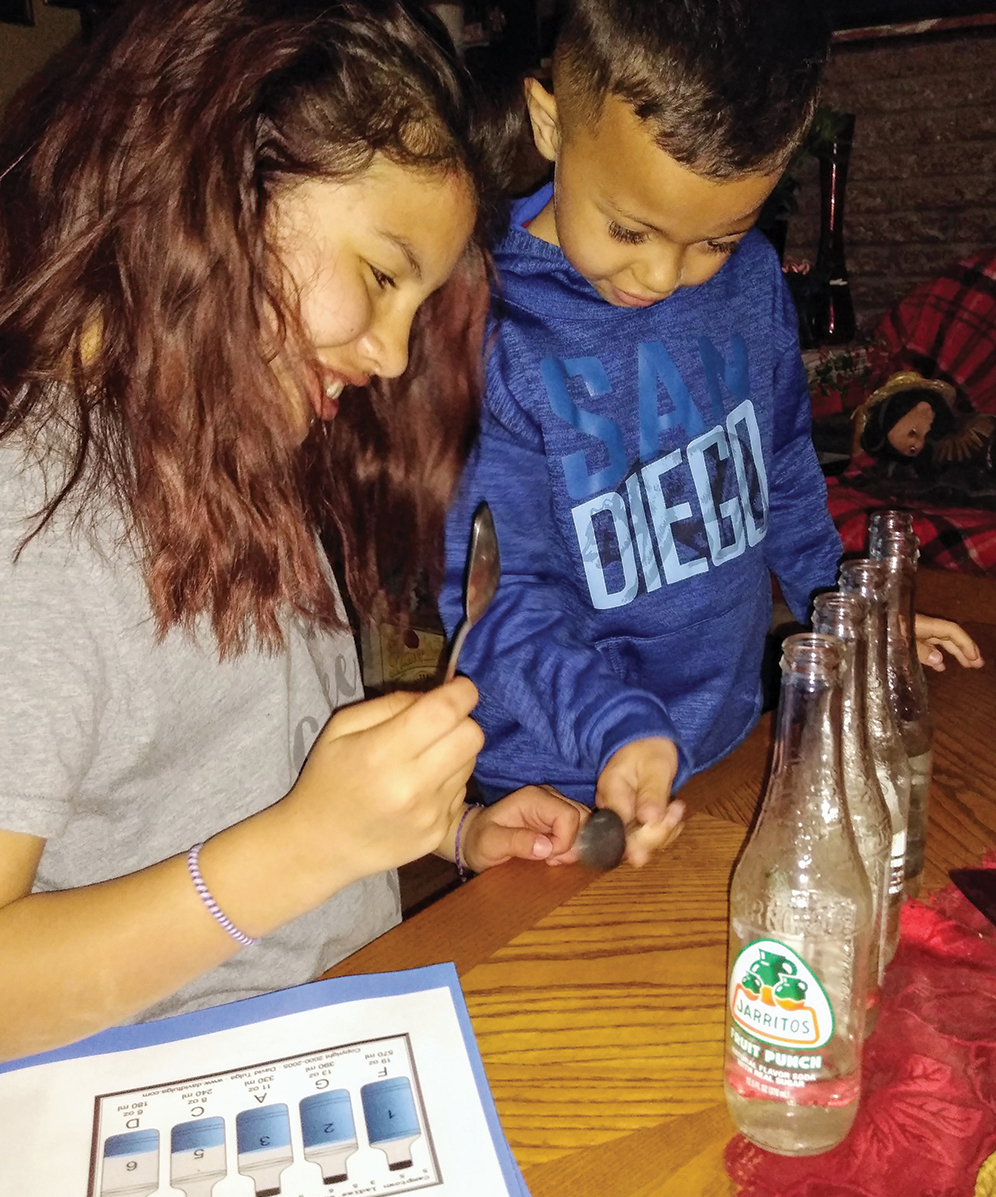
Logistics
We first received our funding for the backpacks from the NASA Idaho Space Grant Consortium, which allowed us to spend approximately $4,500 on the 96 (6 backpacks × 16 classrooms) backpacks. The average cost per backpack—including restocking consumable materials for the school year and the backpack itself—ranged from $15 to $60. We only created four of the more expensive backpacks that had commercially made STEM activities (e.g., a marble run, an electric circuit kit) to keep costs down and to maintain the “grocery store” availability of science activities and materials. Although this was quite costly at the outset, we feel that there are a variety of ways that schools could keep costs down if they do not have grant funding, such as leaving out commercially made STEM activities; using less expensive storage bins rather than backpacks; asking for donations of low-cost materials from families or business partners; asking businesses, universities, or altruistic organizations to sponsor an activity or grade level; or simply crafting the full range of backpacks over time.
At our school, the principal required all students to have a signed permission slip before checking out any of the backpacks. The permission slip is yet another reminder for families to follow science safety rules and to return the materials in a timely manner. Teachers in our school agreed to track the backpacks within their classrooms, creating a small library check-out system. The backpacks are checked out on Thursdays and returned on Mondays so as to provide families with sufficient time to do the activity. When teachers receive the backpacks from the students, they take them to a storage room where a volunteer restocks the backpacks and collects all feedback forms. Occasionally we have students who do not return the backpacks on time, we have been able to contact families via the information provided on the permission slips so that the backpacks are returned a day or two later.
To make it easier for volunteers to step into the restocking role, we have created grade-level boxes with all the materials for the backpacks ready to go, such as string cut to particular lengths, portioned out seeds, and so on. Each backpack has been fitted with a luggage tag (each grade level having their own design or color) that lists the activity and the backpack number (e.g., K— Fly a Kite!— Backpack #3) to aid with both the check-out system as well as restocking. Finally, to keep the reusable activity sheets, materials sheets, and lab assistant’s pages in good shape, we laminated these on construction paper and attached them together with a small binder ring.
Our Own Design Cycle
Just as we encourage students to continually re-engineer their designs in school and in some of these backpack activities, we too have gone through a few design cycles with the science backpacks and see our lessons learned as helpful tips for others wishing to start up a similar program at their school.
Lesson Learned #1: Time Is of the Essence
Families had a variety of responses to our feedback question that asked how long the activity took and whether they felt that amount of time was appropriate. For some, the activity was too long, for others, it did not last long enough. In response to this feedback, we now aim for activities that may take 20–30 minutes. This seems to be enough time to dig into the content but not so much time that it is impossible to complete and becomes frustrating.
Lesson Learned #2: Remember That Teachers Are Busy
The teachers at our school have been incredibly supportive of the science backpacks, but like many teachers, they have a lot on their plates. Having parent volunteers, student leadership groups, or community volunteers trained to assist with the backpacks can help streamline the check-out and restocking processes so teachers do not feel the pressure to do it all. If the principal at your school is supportive of a similar program, you might request regular/weekly assistance from a paraprofessional within the school. However, if finding volunteers to restock backpacks is not possible, restocking one classroom’s backpacks can be done in a half-hour or less if the materials are readily available.
Lesson Learned #3: No Scientist or Engineer Is an Island
The creation of 96 backpacks was no small feat; lesson design, formatting, collecting materials, putting together the backpacks themselves, educating teachers and families, and restocking the backpacks all take an incredible amount of time. Once again, creating a team of volunteers could be useful in terms of “dividing and conquering” all the tasks required to start up and sustain a program such as this.
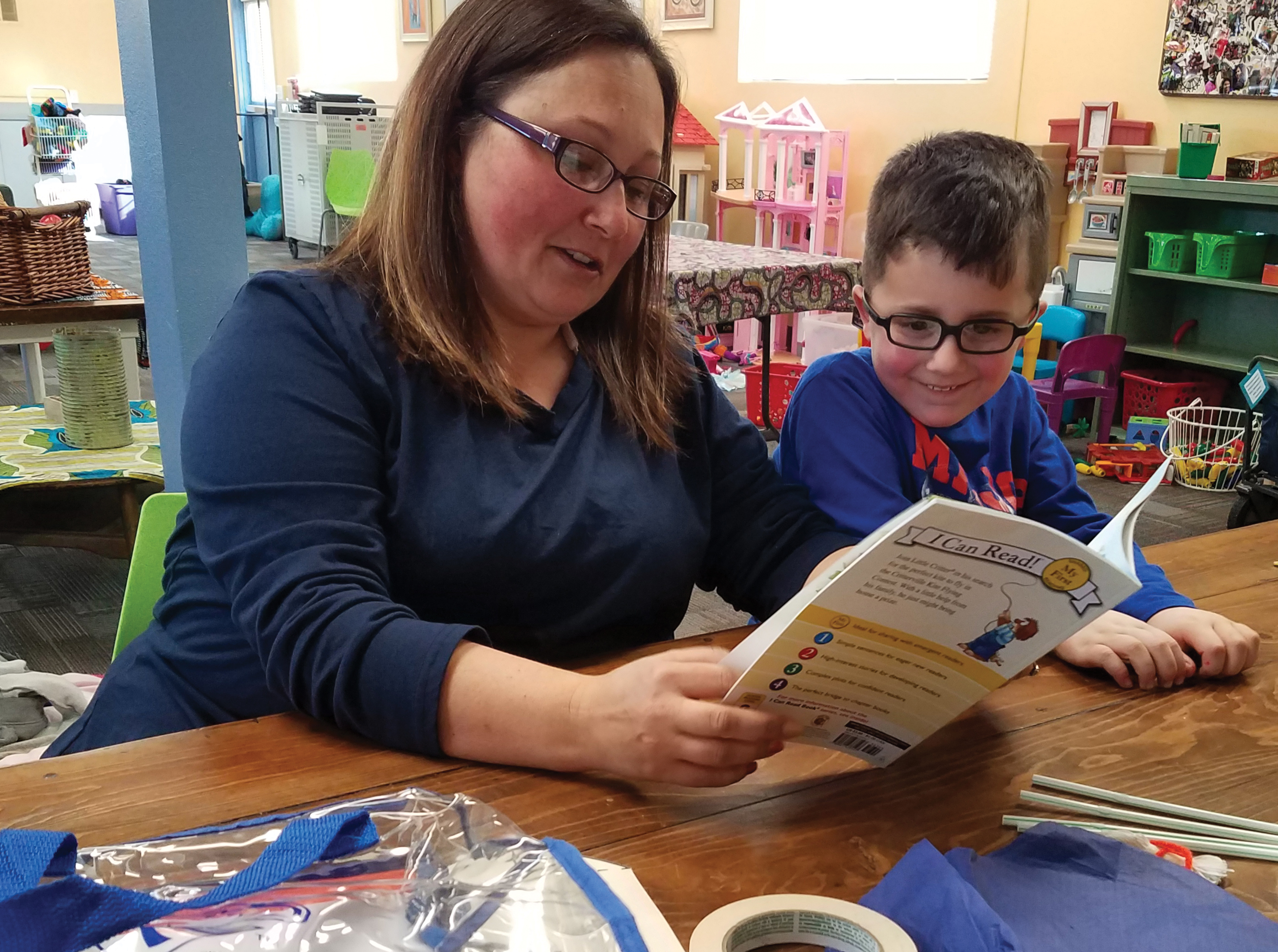
Lesson Learned #4: It’s Worth It
While the backpacks were indeed a huge undertaking, we believe that the hard work has paid off. These backpacks have helped to open families’ eyes to science activities that can be done with materials found around the house and provided a time and space for families to become accustomed to doing science together via a low threat/high yield activity. Further, we feel that our efforts are necessary to deliberately lower the barriers to access to science/STEM outside of the school that can exist in underrepresented populations. Given that our school is a Title I school which is home to students from over 20 different countries and serving numerous special needs programs, we feel that we have effectively lowered a significant barrier to science access among our underrepresented populations. We see the science backpacks as an important step for all of our students and families to see that science is fun, they can all “do” science, and that exploring the backpacks together as a family can foster meaningful conversations and connections.
STEM Teaching Strategies Elementary



